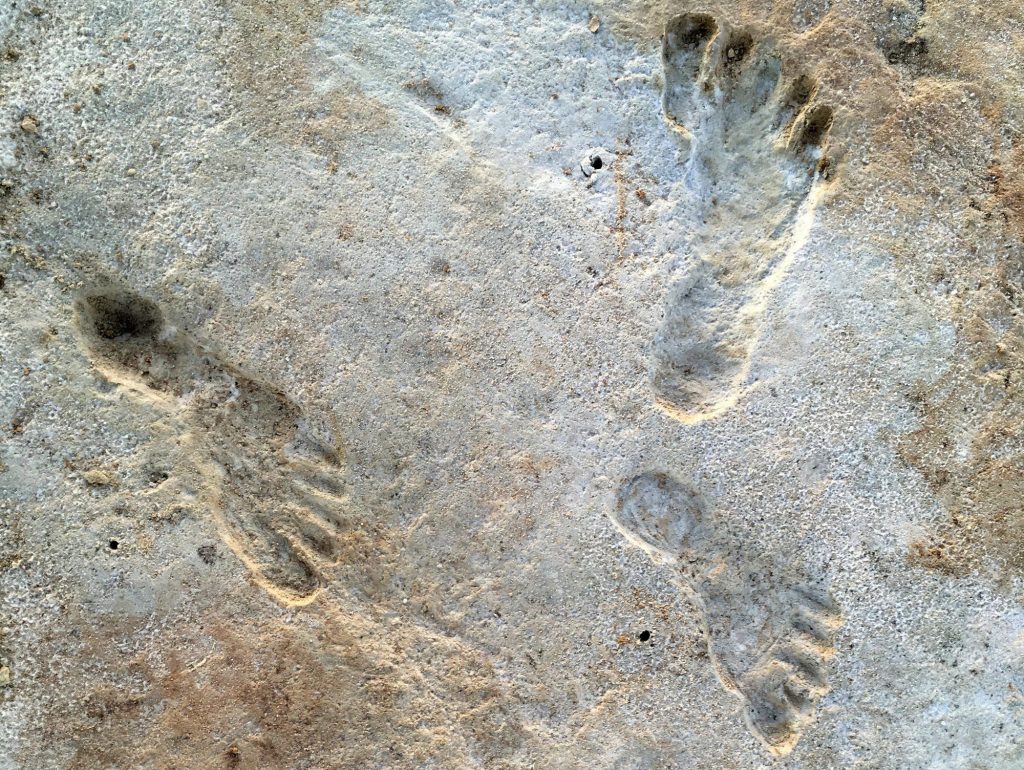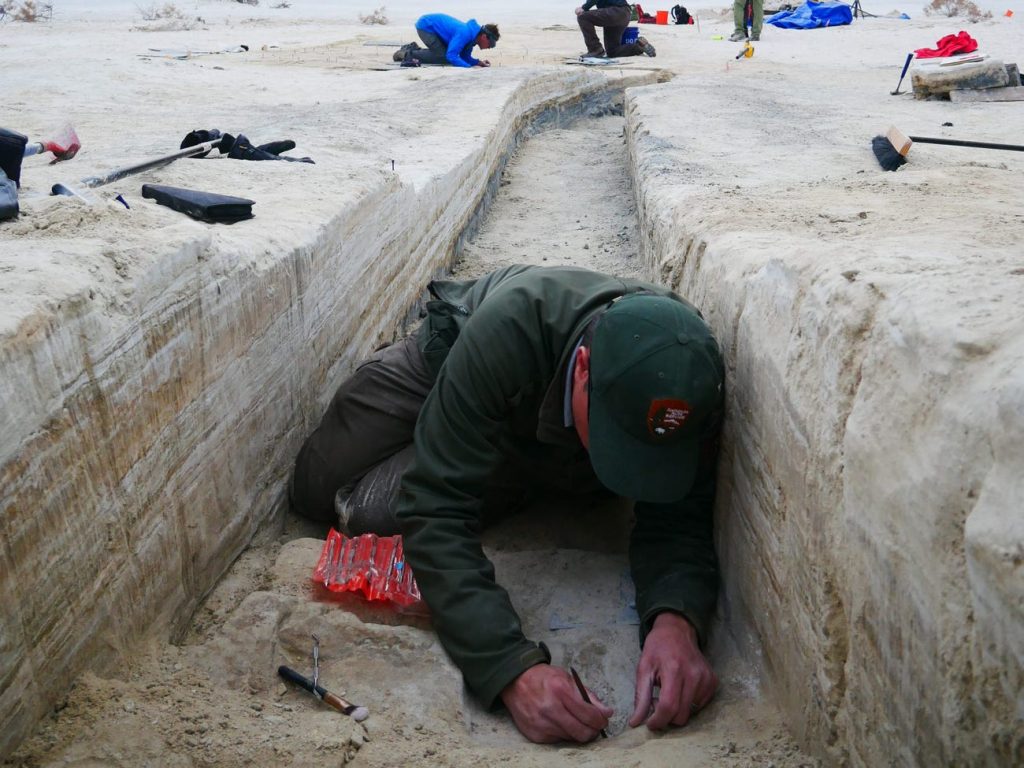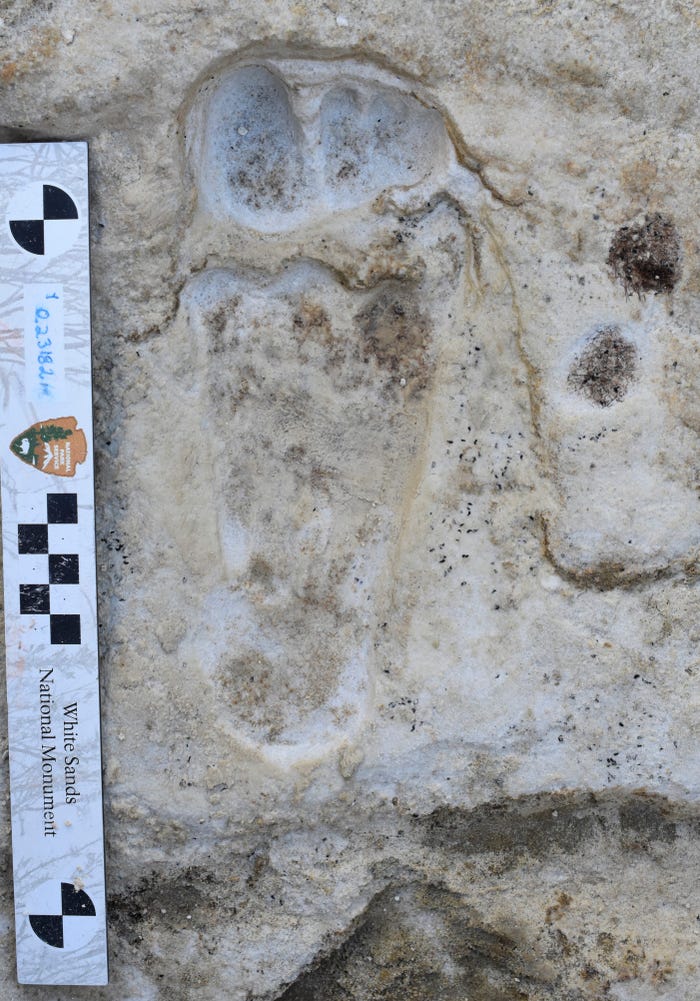
New scientific research conducted at White Sands National Park in New Mexico has uncovered the oldest known human footprints in North America.
The discovery reveals evidence of human occupation in the Tularosa Basin beginning at least 23,000 years ago, thousands of years earlier than previously thought.
“These incredible discoveries illustrate that White Sands National Park is not only a world-class destination for recreation but is also a wonderful scientific laboratory that has yielded groundbreaking, fundamental research,” said Superintendent Marie Sauter.
The fossilized human footprints were buried in multiple layers of gypsum soil on a large playa in White Sands National Park.
Seeds embedded in the footprints were radiocarbon dated and analyzed by the U.S. Geological Survey to establish their age.

The research dramatically extends the range for the coexistence of humans and Pleistocene (ice age) megafauna and confirms that humans were present in North America before the major glacial advances at the height of the last ice age closed migration routes from Asia.
The findings are detailed in an article published in the journal Science.
“This study illustrates the process of science – new evidence can shift long held paradigms,” said USGS Acting Rocky Mountain Regional Director Allison Shipp.
White Sands National Park contains the world’s largest-known collection of Pleistocene age (ice age) fossilized footprints in the world and has been recognized as a megatracksite since 2014.
In addition to human footprints, tracks from the Columbian mammoth, saber-toothed cat, dire wolf, and other ice age animals have been discovered.
White Sands National Park protects and preserves the world’s largest gypsum dunefield, at least 23,000 years of archaeology, adaptive flora and fauna, as well as Works Progress Administration-era historic pueblo buildings.

Why are there footprints in White Sands?
Footprints are a common theme at White Sands. The white dunes of the Tularosa Basin are just a recent blip on the geological timeline. During the ice age tens of thousands of years ago, a giant body of water called Lake Otero existed. The climate was wetter, and the vegetation was abundant. One could have seen grasslands stretching for miles that would have looked more like the prairies of Nebraska than New Mexico’s deserts.
This paradise of lush green life naturally captured the attention of the larger animals of the ice age. Plant eaters of all kinds came to Lake Otero to feast on the grasses and trees of the Tularosa Basin. Large plant-eaters attracted fearsome predators of the ice age, such as dire wolves and the American lion. Throughout the ice age, these animals left their footprints along the wetlands of Lake Otero.
Around 12,000 years ago, the earth’s climate began to show signs of change. Areas once green and lush started transforming into the desert landscape we see today. Rainfall in the Tularosa Basin became rare, and the great Lake Otero began to dry. The once large body of freshwater became only pools of water scattered along the former lakebed.
As the waters of Lake Otero dried, crystals began to form from the gypsum left behind by the evaporating lake water. The constant blowing of the wind broke down those large crystals into smaller crystals. This eventually formed the white sand dunes that gave this park its name.
How long have humans been living in the Tularosa Basin?
The latest research from White Sands confirms for the first time that humans have been living in North America for at least 23,000 years – many thousands of years older than previously thought. This research also confirms that people were living with the ice age megafauna much longer than previously known.
The new dates of the human presence were discovered by digging a trench in the gypsum soil on the park’s western playa. Human footprints were found at different depths below the surface. Above and below these nearly discovered human footprints were ancient grass seeds (Ruppia cirrhosa). These seeds were analyzed using radiocarbon dating, and calibrated dates of 22,860 (∓320) and 21,130 (∓250) years ago were revealed.
Based on stature and walking speed, it appears that most of the footprints in this study come from teenagers and children. One hypothesis for this is the division of labor, in which adults are involved in skilled tasks whereas ‘fetching and carrying’ are delegated to teenagers. Children accompany the teenagers and collectively they leave more footprints and are preferentially recorded in the fossil record. This pattern is common to all excavated surfaces.
In summary: Newly discovered fossil footprints show humans were in North America thousands of years earlier than we thought. Scientists found 60 human footprints between 21,000 and 23,000 years old, indicating humans occupied southern parts of the continent during the peak of the final ice age. [Science, NPS1, NPS2]
Now subscribe to this blog to get more amazing news curated just for you right in your inbox on a daily basis (here an example of our new newsletter).
You can also follow us on Facebook and/ or Twitter. And, by the way you can also make a donation through Paypal. Thank you!
You should really subscribe to QFiles. You will get very interesting information about strange events around the world.














I don’t think those are human foot prints. Humanoid meaning they resemble. Fallen Ones here before Adam. Those beings did not possess the capacity to be filled with the Holy Spirit. Don’t be deceived.
Large human footprints along with known dinosaur footprints are found in sedimentary rock on the Paluxy river in Texas. This was nearly 100 years ago. Some of the human footprints overlapped or were inside of dinosaur prints, proving that the two were contemporaneous. Naturally this was “debunked” by the fact checkers of the time as being carved in the rocks as a hoax.
A group of researchers sometime in the 50s or 60s (I don’t remember exactly) accepted the challenge, took some heavy equipment to the site and excavated more foot prints while filming the event (on film, not video tape). This was long before fake videos could be made. I saw the film myself. The makers of the film found an unusually large man suffering from acromegaly and his footprint fit quite well into one of the fossilized prints.
The best part of the movie they made was the subsequent interviews with scientists of the day. Even after seeing it themselves, they adamantly refused to believe the truth. The squirming and ridiculous “explanations” was priceless.
If you research the above story you see some of the same kind of responses from “scientists” regarding the footprints in Mexico.
Facts in themselves cannot be “controversial”. The word “controversial” simply means “so-called experts reject the truth”.
https://duckduckgo.com/?q=six+toes+%2B+Nephelim+&t=h_&ia=web
?Nephelim articles.
Who give a crap???
Question to ponder.
Do spiritual beings in spiritual bodies leave foot prints?
I say they will, and did in the past.
Nephelim —on that big one. I didn’t check for six toes yet.
They could be fakes too.
I see a sixth toe on that big one. ?
How about some measurements on that big footprint?
UFO’s were around there too. So they say, The White Sands Incident.
We had a book on it in our house library. This is when people had encyclopedic books for research.
Six toes? Or faked?
https://www.thegatewaypundit.com/2021/09/surprise-another-hate-hoax-black-emory-university-employee-arrested-vandalizing-autism-center-racist-anti-semitic-graffiti/
May as well post this phenomenon. Looks like we have a black skinhead to go with the Nephelim hoax?
https://www.westernjournal.com/search-brian-laundrie-ramps-duane-dog-chapman-appears-family-home/
Another phenomenon today. Surprise, Dog the Bounty Hunter. No haircut in 25 years?
Ha, nobody else noticed six toes on the larger footprint.
Fake Nephelim or real? Nobody knows? I figured after a week someone else would notice. ZZZzzzzzzz